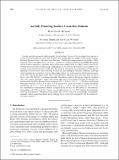An Eddy-Permitting Southern Ocean State Estimate
Author(s)
Mazloff, Matthew R.; Heimbach, Patrick; Wunsch, Carl Isaac
DownloadMazloff-2010-An Eddy-Permitting S.pdf (4.988Mb)
PUBLISHER_POLICY
Publisher Policy
Article is made available in accordance with the publisher's policy and may be subject to US copyright law. Please refer to the publisher's site for terms of use.
Terms of use
Metadata
Show full item recordAbstract
An eddy-permitting general circulation model of the Southern Ocean is fit by constrained least squares to a large observational dataset during 2005–06. Data used include Argo float profiles, CTD synoptic sections, Southern Elephant Seals as Oceanographic Samplers (SEaOS) instrument-mounted seal profiles, XBTs, altimetric observations [Envisat, Geosat, Jason-1, and Ocean Topography Experiment (TOPEX)/Poseidon], and infrared and microwave radiometer observed sea surface temperature. An adjoint model is used to determine descent directions in minimizing a misfit function, each of whose elements has been weighted by an estimate of the observational plus model error. The model is brought into near agreement with the data by adjusting its control vector, here consisting of initial and meteorological boundary conditions. Although total consistency has not yet been achieved, the existing solution is in good agreement with the great majority of the 2005 and 2006 Southern Ocean observations and better represents these data than does the World Ocean Atlas 2001 (WOA01) climatological product. The estimate captures the oceanic temporal variability and in this respect represents a major improvement upon earlier static inverse estimates. During the estimation period, the Drake Passage volume transport is 153 ± 5 Sv (1 Sv ≡ 106 m3 s−1) [(1 Sv = 10 superscript 6 m superscript 3 superscript -1)]. The Ross and Weddell polar gyre transports are 20 ± 5 Sv and 40 ± 8 Sv, respectively. Across 32°S there is a surface meridional overturning cell of 12 ± 12 Sv, an intermediate cell of 17 ± 12 Sv, and an abyssal cell of 13 ± 6 Sv. The northward heat and freshwater anomaly transports across 30°S are −0.3 PW and 0.7 Sv, with estimated uncertainties of 0.5 PW and 0.2 Sv. The net rate of wind work is 2.1 ± 1.1 TW. Southern Ocean theories involving short temporal- and spatial-scale dynamics may now be tested with a dynamically and thermodynamically realistic general circulation model solution that is known to be compatible with the modern observational datasets.
Date issued
2010-05Department
Massachusetts Institute of Technology. Department of Earth, Atmospheric, and Planetary SciencesJournal
Journal of Physical Oceanography
Publisher
American Meteorological Society
Citation
Mazloff, Matthew R, Patrick Heimbach, and Carl Wunsch. “An Eddy-Permitting Southern Ocean State Estimate.” Journal of Physical Oceanography 40.5 (2010) : 880-899. c2010 American Meteorological Society
Version: Final published version
ISSN
0022-3670
1520-0485